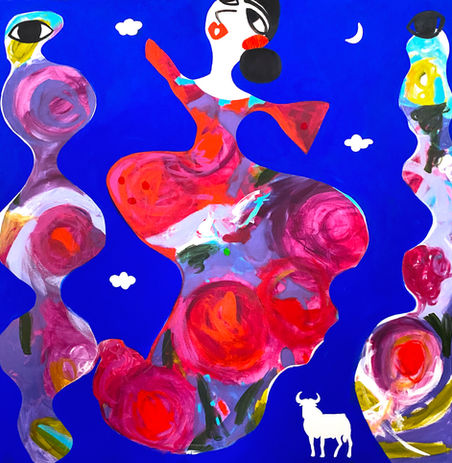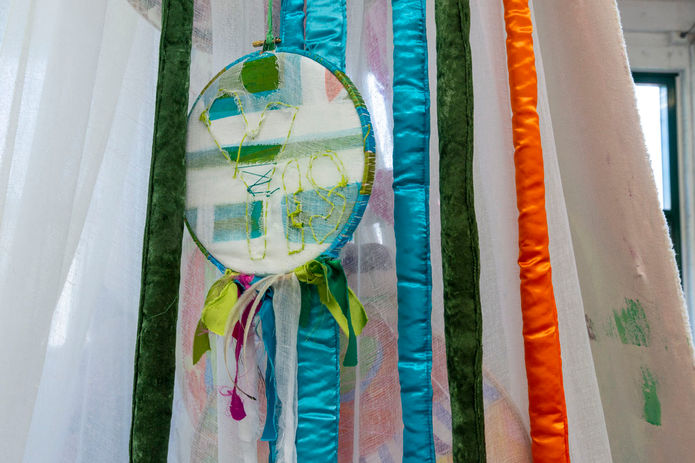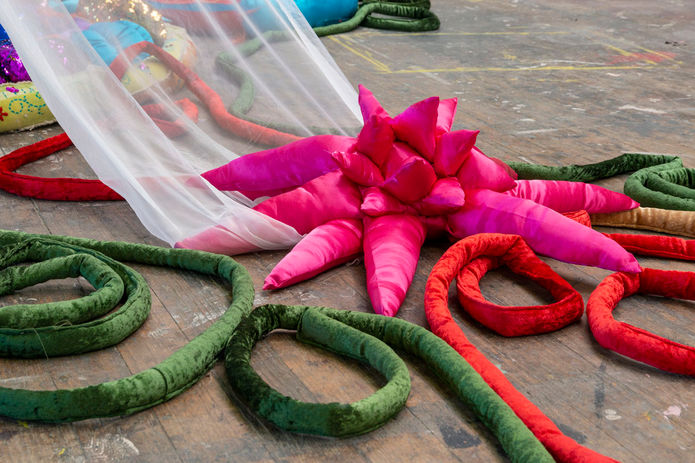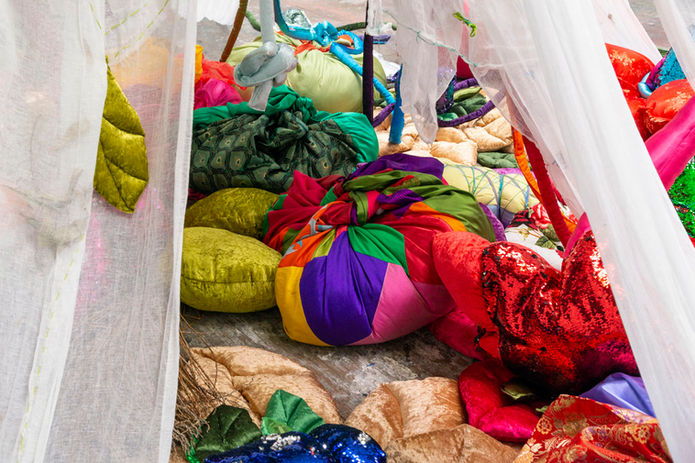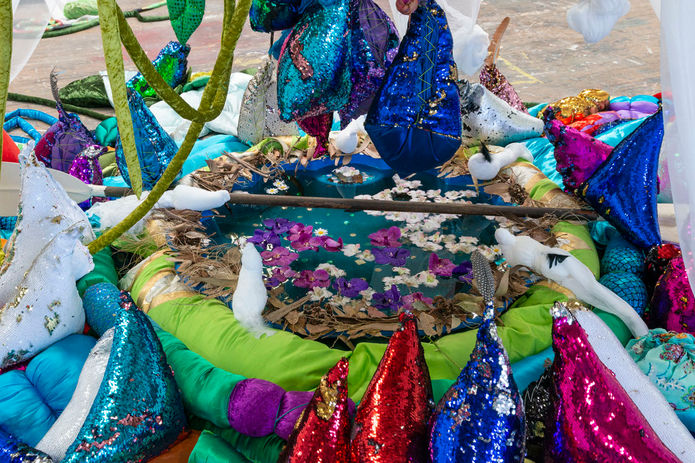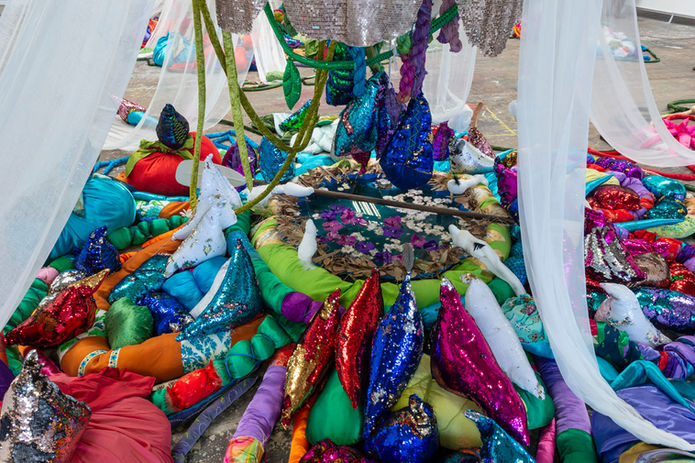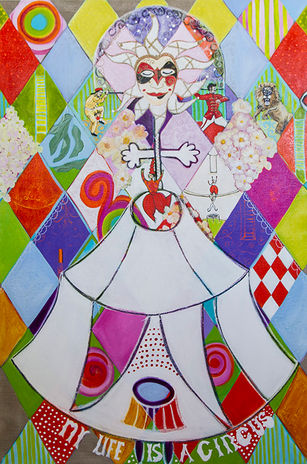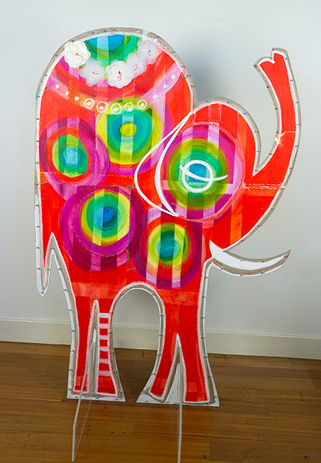
Past Exhibitions
2021
Making Nonsense
Fortyfivedownstairs Gallery
An expanded exploration of the oversized soft-sculpture installations Janno produced during her Masters' studies at VCA (2017-18), Making Nonsense is her response to the pandemic of 2020 with all its accompanying crises, upheaval, and disorientation. Understandable as a defiant celebration of life, resilience, humour, and absurdity, Janno’s enduring preoccupations as an artist encompass ideas about compassion, love, and community as the sustaining principles of a kinder world.
2019
National Gallery of Victoria
Art of Dining, Best of the Best
Janno represented Victoria College of the Arts at the NGV in 2019 and created a table, and installation based on stories of Cleopatra, Mark Antony, love... The brief referenced Tiepolo, Christian Dior, Cecil Beaton, Masked gala balls, Venice, Salvador Dali, sumptuous feasts, pearls, lust, betrayal ...and lavish excess. A perfect brief made for Janno and she spent 6 months hand sewing, painting, and imagining her installation and had much help from her family, CWA ladies, local builders, vintage finds, friends to see it to fruition---a Table and labour of love.
2018
VCA Masters exhibition,
Melbourne University
Cocoon
Excerpt from my writings 'Tales of a Practice'... 2018
"Life and art can be crazy and inseparable, and the ‘cocoon’ materialised in my practice as if a ‘puff of smoke’ from an Aladdin’s magical lamp. A structural and ephemeral metaphor to articulate the possibilities and importance of safe space and refuge for all those who might be endangered or vulnerable. To represent those things that ‘can’ or can’t be spoken, the ‘cocoon’ in essence mutated, transforming from an earlier incarnation of a hot air balloon with associated personal ties to a vulnerable, and profoundly autistic son, threaded to notions of escape, voyage, freedom, childhood and of holding on and letting go. The ‘cocoon’ in the space of my imaginings is a nest-like den, with soft opalescent walls of downy fluff that offer possibilities of shelter and respite. There are circular windows in this protective womb of space, overlooking rolling green fields of forest wildflowers and cascading water. Birds sing, bees hum, dogs bark, children play and tell their stories. A ‘Noah's Ark’ of cocoon that embodies life, encompassing home, fragility, mother, nature, nurture, metamorphosis, time and ancient references such as Ovid and the prehistoric statue of the Venus of Willendorf."
2015
Forty Five Downstairs
Look Up - Brave Up
Look up –June 2015
Look up is a body of work about humanity and reconnecting with nature. Janno explores fragility and the concept of the empty nest as her children grow up and exercise their independence. The exhibition is a call to experiencing the real and actual world around us.
Janno’s artworks seek to sow hope, bravery, love, optimism, resilience and whimsy. They are anchored by a deliberately ridiculous and unwavering sense of humour and bemusement. Her approach is unapologetically bold with a preference for blazing colour and mixed media. She deploys text, thread and richly associative metaphors to portray the most vulnerable, fragile and endangered in society.
In her previous solo exhibitions, Janno has explored the theme of the outsider; the foreigner living in a non-English speaking world; the disenfranchised urban poor; and closer to home and as the mother of a child with autism, the isolation of disability.
Look up portrays the plight of nature and the outsider in a collection of large, abstract, colour-fuelled paintings, oversized sculptures, and smaller, intimate, sewn paper works.
Look up-Brave up October 2015
As happens in life, we get thrown unexpected challenges.
Look up has ballooned and taken on its own uncharted journey, exploding into a defiant herald to live.
Look up continues to be a body of work about humanity and reconnecting with nature and now extends to explore janno’s own fragility as she herself defies the possibility of her own extinction.
The empty nest is now lined with messages of hope and love from friends and family around the world in order to weave safety, love and support for her three boys.
(Look up has undertaken a metamorphous into Brave up) edited by Rose Lang
2014
Who Moved My Elephant
-Who Moved My Elephant- is a body of work about the transition of return to Australia after a prolonged absence and the ironies of coming ‘home’ to a country that is simultaneously deeply familiar and strangely alien. Janno’s artworks seek to sow hope, bravery, love, optimism, resilience and whimsy; - anchored by a deliberately ridiculous and unwavering sense of humour. Her approach is unapologetically bold with a preference for blazing colour and mixed media. She deploys text, thread and richly associative metaphors to portray the most vulnerable, fragile and endangered in society. In her previous solo exhibitions, Janno has explored the theme of the outsider; the foreigner living in a non-English speaking world; the disenfranchised urban poor; and closer to home and as the mother of a child with autism, the isolation of disability. ‘Who Moved My Elephant’ continues to portray the plight of the outsider in a collection of large, abstract, colour-fuelled paintings and smaller, intimate, paper works and sculptures.
Mars Gallery
2012
Querido Alfredo
This exhibition, “Querido Alfredo”, was initially inspired by an Argentine love story from the 1920s and is itself a journey of love, travel and friendship.
The exhibition is what it is, a work in progress without any real beginning or end, a snap shot of a years toil living abroad in a foreign culture.
The thought processes and ideas that thread my works and installations appear intentionally at surface light, quirky, zany and ludicrous but contrast with roots profoundly deep, considered, poignant, heartfelt, and at times extremely painful. Ideas explode in colour and thread and multiply leading to other people, other lives, loves and stories. This exhibition is a culmination of just that and the linking thread is love.
The seed for “Querido Alfredo” began to sprout a year ago on a sunny afternoon whilst wandering amongst the stalls of my favourite flea market in Buenos Aires. The quirky collection of store holders there is just as intriguing as the wares that are on display. Gnarled faces, gritty teeth and broken smiles offer stories in rough, melodic Spanish, and it was there that I discovered an old dusty shoebox crammed with aged papers and found amongst the flotsam five hand stitched love letters.
I thought them exquisite and on closer inspection realised that the author, Julia, had sewn them herself for her absent lover Alfredo. That she loved this man was obvious, by the words and the time that it must have taken to sew her love into these painstaking silk stitches. I pondered Alfredos whereabouts and my imagination propelled itself into overdrive, conjuring romantic absences and wild adventures. The setting was 1920s, the main characters were Julia and Alfredo and everything else was a mystery so would have to be invented.
In my musings, Alfredo travelled by ship, danced and rode elephants, wrestling lions in far off lands. Travel in that era seemed much more exotic and romantic, a far cry from the invasive security checks and impersonal travel of today, where we are herded roughly through gates and thrown food in paper bags as we walk nervously onto planes, wondering if and in what state we are going to surface at the other end.
Whether real or imagined each of us has our own stories of love be they unrequited, fiery, passionate, painful, brotherly, maternal or everlasting.
In my writing and paintings, the most important or difficult of loves are hovering in the spaces between the pages’ leaves, unnamed, too private, too painful, too precious…
It is the blank spaces on my canvases and the empty white pages that are the most poignant. These spaces on the canvas stay white to protect the viewer from their content and to protect me from exposing my pain.
There is an innocence and naivety in white which I am holding onto for dear life. White promises beauty and peace, protection, and privacy.
There is a space of gentle hope. White does not represent nothing, it represents everything that cannot be said and cannot be painted. White is the pain and anguish of loving my vulnerable child who is disabled and alone except for us.
White is the smile that I wear to pretend that everything is fine in order to not further alienate us from friends and family who cannot understand. White gives light and takes away the darkness of black. There is a lot of white .
Janno








